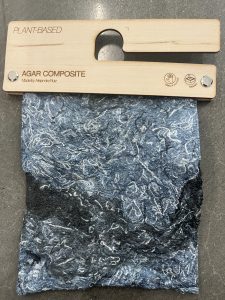Ingredients
- Agar – 5 g polymer (makes it hard)
- Glycerine – 15 g plasticizer (makes it flexible)

- Water – 250 ml/g solvent, to dissolve and heat the agar
- A piece of textile large enough to fit over the mold
- A mold for example a bowl, or other 2.5D or 3D surface
Tools
- Spoon
- Scale
- Bowls to weigh ingredients
- Cooker (ideally temperature controlled)
- Thermometer (optional) if you don’t have a temperature controlled cooker
- Small molds – 2x such as two glass bowls of about 8 cm diameter (or equivalent) that slide into one another.
Yield
Before processing/drying/curing: approx. 200 ml this is enough to make a small 15x15cm composite and the agar foil.
Method/Procedure
- Preparation
- Weigh your ingredients
- Prepare the casting surface and find a place where you can leave it for a while, ideally near an open window where there’s air flow.
- Mixing and dissolving the ingredients
- bring the water to the boil
- optional: substitute part of the water with natural dye if you wish to use color
- add the glycerine
- add the agar
- bring the mixture to a boil while stirring gently, to dissolve the agar.
- Cooking the ingredients
- when the agar is dissolved completely, lower the temperature to 60-80 degrees (make sure it doesn’t bubble), and let it simmer and evaporate water for 40 mins while stirring slowly and continuously.
- the agar should have the consistency of a light syrup, you should be able to leave a “trace” with you trace your spoon across the pot.
- If your mixture is thicker it will spread slowly resulting in a thicker foil, if it’s more liquid, it will spread wider, resulting in a thinner foil.
- Casting and molding
- Dip the textile(s) into the hot liquid
- Take it out and position on the mold, press it down with the second bowl.
- After an hour, take off the second bowl and let the composite airdry on top of the mold
